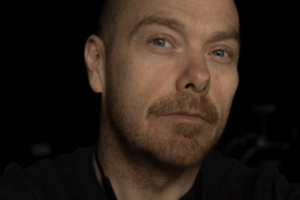Frode Oldereid & Thomas Kvam
Meta.Morf 2024 – [up]Loaded Bodies / Kjøpmannsgata Ung Kunst / April 18 – August 18 /
Curators: Zane Cerpina, Boris Debackere, Espen Gangvik, Florian Weigl.
Requiem for an Exit (2024)
This towering and monumental creation is set to deliver a monologue that tackles the complex question of evil. Through the lens of the robot, envisioned as a machine-human hybrid, evil is not portrayed as a product of political ideologies, moral deficiencies, class distinctions, or religious beliefs. Instead, it is depicted as inherent dispositions embedded within the human genome. This approach introduces a provocative stance of biological reductionism as the project’s foundational premise.
At the heart of this investigation lies the intriguing presence of Neanderthal DNA within the genetic makeup of contemporary human populations. This genetic legacy is the outcome of ancient interbreeding between Neanderthals and early modern humans as they ventured out of Africa into Europe and Asia. Studies indicate that about 1.5% to 2.1% of the DNA in individuals with Eurasian ancestry can be traced back to Neanderthals, with variations noted across different populations. A persistent mystery surrounds the abrupt disappearance of the Neanderthals: What circumstances led to their extinction? The installation’s robot presents a haunting theory, positing that the eradication of Neanderthals might constitute the first instance of genocide committed by humans. Seen through the prism of Nietzschean philosophy, this primordial act of genocide reverberates through history, manifesting in various forms from the conquests of Genghis Khan to the atrocities of the Holocaust.
The robot suggests that the remnants of Neanderthal DNA serve as a living memorial to this ancient genocide, a permanent mark of an entire species wiped from existence. As the narrative unfolds, it probes the implications of this genetic heritage for the future, especially as humanity stands on the brink of becoming an interplanetary species. This contemplation extends beyond a mere reflection on the past, urging a reconsideration of what such genetic legacies might mean for our ethical and existential journey forward.
This speculative framework allows for a deep exploration of the biological underpinnings of behavior, pushing the audience to reconsider the origins and manifestations of what is traditionally deemed ‘evil.’ Are we not already encoded, with behavioral algorithms inscribed in the double helix of destiny that is our DNA?

“Requiem for an Exit” by Frode Oldereid & Thomas Kvam.
 Frode Oldereid (NO)
Frode Oldereid (NO)
Frode Oldereid (born in 1966 in Norway) is a university college lecturer in audiovisual subjects. His career in the music industry took root in Bergen during the early 1980s. By the 1990s, Oldereid had immersed himself in Oslo’s vibrant experimental art and theater scene, showcasing his versatility as a composer and sound designer.
His creative outputs span music compositions and sound designs for both art installations and theatre productions. Oldereid has also made his mark on the international stage, touring extensively with a variety of performances and installations. From 1997 to 2004, he dedicated himself to “The Machine Project,” a period marked by significant touring and exhibitions in various venues, including galleries, museums, and concert halls.
With education as a sound engineer and in documentary filmmaking, video editing, and photography, he has worked in all these fields. He has significantly contributed to numerous Norwegian studio productions in the capacity of a sound engineer. His visual works range from commercial productions for TV, art installations, to scenographic elements in the form of still image tableaux. Academic education in TV production, urbanism, sociology, media, and mass culture has influenced his productions.
Supported by Arts Council Norway / Co-produced by TEKS
 Thomas Kvam (NO/DE)
Thomas Kvam (NO/DE)
Thomas Kvam, a Norwegian artist and author born in 1972, has carved out a distinctive niche in the art world through his integration of art, activism, and technology. His repertoire, spanning conceptual art, publishing, and literature, showcases his utilization of diverse mediums, from robotics to painting. Kvam’s scholarly background, with master’s degrees from the National Academy of Fine Arts in Oslo and Goldsmiths College in London, along with a Ph.D. from The Art Academy in Oslo, underpins his often controversial artworks that probe deeply into socio-political issues.
Kvam’s artistic journey encompasses three distinct phases. Initially, beginning in 1995, he gained recognition for his installations that combined robotics, video, and sound, captivating an international audience until 2004. He then transitioned to creating animation films, with political satire as a central theme. His work “Eurobeing” (2006) was notably included in the collection of the Pompidou Center.
In 2010, Kvam embarked on a venture into independent publishing with his Office for Contemporary Anarchy, releasing titles such as “Emokonseptualisme” (2010), “Rantology” (2011), and a provocative compilation of censored war photographs from Iraq and Afghanistan, titled “nowthatsfuckedup/Krieg dem Kriege” (2011). The war photography book laid the groundwork for a decade-long project titled SchizoLeaks. In the installation work “The Chosen Five” (2015), Kvam used facial recognition software to identify five US soldiers as war criminals, based on photographic evidence of breaches of the Geneva Convention..
“SchizoLeaks,” a comprehensive retrospective at Haugar Kunstmuseum in Norway (2021), encapsulates Kvam’s conceptual art philosophy. The exhibition showcased how Kvam, drawing inspiration from WikiLeaks’ strategies, utilized art as a platform for unveiling undisclosed documents. This approach forced viewers to face unsettling truths, thereby exploring the legal and ethical boundaries within contemporary political discourse.
As a writer, Kvam published his first novel, “Homo Sacco,” released by Cappelen Damm in 2017. His literary work, spanning from conceptual poetry to essays and shorter stories, complements his visual art, offering both narrative and theoretical contexts to his art production. Kvam is a co-founder and editor of the biannual art and literature publication Gespenster, to which he also contributes as a writer.
Kvam’s art, installations, paintings, and video works have been displayed in a variety of settings, including solo and group exhibitions, in museums and galleries internationally. Kvam’s career, marked by a continuous commitment to challenging audiences, is a testament to his ability to provoke critical thought and dialogue through his art. His works are not just visual experiences; they are a deep dive into the complexities of human psychology, aesthetics, and ethics, and the challenging balance between public knowledge and private life.
Header Graphics: “Requiem for an Exit”, courtesy of the artists.